Part IV: Pleistocene Epoch
23. Homo habilis
Homo habilis (2.3 mya)
(“human” / “handy,” “able,” etc.)
SITES
Ethiopia: Hadar (and possibly Omo)
Kenya: Koobi Fora
Tanzania: Olduvai Gorge
South Africa: Swartkrans and Sterkfontein
PEOPLE
Mary and Louis Leakey, Donald Johanson, Tim White, and others
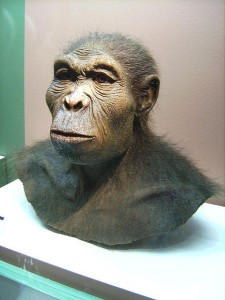
Of the two species of Early Homo, Homo habilis is the favored ancestor of Homo ergaster and all subsequent hominin species.
PHYLOGENY
While the origin of Homo habilis has been in a state of flux in recent years, the discovery of Au. sediba has raised more questions about the origin of our genus. The discovery of Lucy in the early 1970s led some researchers to turn away from Au. africanus in favor of Au. afarensis as the ancestor of genus: Homo. In recent years, the idea that a cladistic event had occurred with Au. afarensis, leading to Au. africanus and the more derived robust forms on the one hand and genus Homo on the other, gained in popularity. Au. sediba now seems to have bridged the gap between the australopiths and genus Homo, sharing characteristics with Au. africanus, H. habilis, and H. ergaster. The similarities with the two Homo species may help resolve the problem as to which of the two species of “Early Homo” gave rise to H. ergaster. There are proponents in support of each of the evolutionary scenarios, with their share of pros and cons.
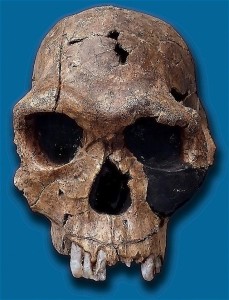
DISCOVERY AND GEOGRAPHIC RANGE
Louis and Mary Leakey discovered the first fossil material in 1960 at their site in Olduvai Gorge, Tanzania. Louis had been recovering stone tools from the site for years, but the manufacturer of those tools had previously eluded him. He named the species Homo habilis or “handy-man.” Fossils attributed to H. habilis have also been found at Hadar (and possibly Omo), Ethiopia; Koobi Fora, Kenya (see Figure 23.2); and the South African sites of Swartkrans and Sterkfontein.
PHYSICAL CHARACTERISTICS
H. habilis exhibited a high degree of sexual dimorphism, with males and females weighing 114 and 70 lb and standing 5´2˝ and 4´1˝, respectively. Their skull, face, and dentition were more gracile than the australopiths. Their teeth and dental arcades were very human-like. The skull base was flexed, as seen in Au. africanus and the more derived robust australopiths and, relative to past species, the skull was rounder and higher, reflecting architectural changes in the brain. Cranial capacity ranged from 500 to 800 cc with a mean of 631 cc. This gave them an EQ of 3.1–3.5. At this point in hominin evolutionary history, we see increased asymmetry in the two hemispheres of the brain, termed lateralization or left hemispheric dominance. The left side of our brain is involved with language and analytical processes. Like all Old World monkeys and apes, H. habilis possessed Broca’s area, which is involved with language production. However, it was larger than in past hominin species, and they also possessed Wernicke’s area, which plays a role in language comprehension. They thus had the neural capacity for language. The left hemisphere is also related to right-handedness. They may have exhibited our tendency to hold objects with our left hand while working on them with our right. The frontal lobe, important in association processes, was expanded and resulted in more of a vertical forehead. The enlarged brain may have been facilitated by a decrease in gut volume, combined with a higher-quality diet that resulted from increased cognitive capabilities and an expanded technology base.
H. habilis had a smaller supraorbital torus and its face was more orthognathic than its supposed ancestor, Au. africanus, but they retained some prognathism in the lower face. They had fairly large ape-like incisors, but their canines, premolars, and molars were reduced in size. The mandible was more gracile, reflecting their reduced masticatory capabilities.
Like the majority of the australopiths, H. habilis possessed elongated arms, possibly suggesting continued reliance on an arboreal environment. While the digits were still curved, they had increased gripping capabilities for tool manufacture and use, as evidenced by the pronounced attachment site for the flexor pollicis longus muscle, which acts to flex the thumb.
The femoral head was enlarged and the neck shortened. Those changes are thought to have been the result of increased strain generated by an expanded pelvis for birthing larger-brained infants. However, no fossilized pelvic fossils have been found. Their foot was more modern, in that the hallux was no longer divergent but rather aligned with the lateral four digits, and the toes were shorter. They had less mobility in their feet, in that the foot had become more of a support structure like our own. The metatarsals were thick relative to modern feet, and the morphology of the third metatarsal suggests that they did not yet exhibit the degree of weight transfer and propulsive capabilities seen in modern humans.
Review of Primitive Characteristics
- Some prognathism.
- Large incisors.
- Curved phalanges.
- Long arms and short legs.
- Thick metatarsals.
Review of Derived Characteristics
- Gracile craniofaciodental characteristics:
- Thin skull vault.
- More globular cranium.
- Expanded frontal lobe.
- Left hemispheric dominance.
- Enlarged Broca’s and Wernicke’s areas.
- Reduced supraorbital torus.
- Smaller mandible, canines, and cheek teeth.
- Parabolic dental arcade.
- Increased manual dexterity.
- Larger femoral head (and hence acetabulum) and shorter neck.
- More stable foot:
- Loss of divergent hallux.
- Shorter toes.
ENVIRONMENT AND WAY OF LIFE
Certainly one of the most interesting things about H. habilis is the appearance of a much more extensive archaeological record. The cultural period at that time, and extending through Homo erectus, is termed the Early Paleolithic, or the early portion of the Old Stone Age. While other species apparently preceded H. habilis in the manufacture of tools, it was thought for many years that they were the first to do so. The Oldowan or Olduwan tradition (industry and technology are also used synonymously with “tradition”), named after Olduvai Gorge, consisted of simple core tools and flakes. The technique involved the selection of a cobble (a workable-sized rock), followed by the use of a hammerstone to remove the outer rough surface (see Figure 23.3) or “cortex” and then to shape it into a core tool, by the removal of flakes. The flakes that are removed may be suitable for cutting and slicing. The process is called hard percussion, and the shaping is known as lithic reduction. “Lithic” refers to stone and is also used to denote a stone tool. Stone resources for the manufacture of tools were chosen for their suitability and transported across the landscape. Of course, this indicates a level of cognitive complexity, but we must remember that chimps and orangutans choose sticks and grass of particular widths and strengths, trim them to the appropriate length, and transport them in their mouths to their site of intended use. Apes learn by trial and error, innovation and imitation, and cultural transmission, i.e. traits spread throughout a group by observation. Cultural transmission of innovations is even seen in monkeys, e.g. Japanese macaques washing sweet potatoes, skimming grain kernels floating on the surface to separate them from beach sand, and bathing in volcanic springs. While we do not know which species was the first to invent stone tools that were modified from their original form via lithic reduction and shaping, we can see the precursors of innovation and cultural transmission in our primate relatives. The real skill comes with having the manual dexterity to do so, making a tool that can accomplish a variety of uses, and the ability to teach others. I would argue that the earliest members of our genus had “theory of mind,” i.e. the realization of another’s thoughts. There is only one example of teaching in nonhuman primates and that was a mother chimp in the Tai Forest of the Ivory Coast that helped her daughter crack a nut, using their unique hammer and anvil technique. Our closest relatives, with all of their intelligence, symbolic capabilities as demonstrated in language studies, and similarities to our own behavior, do not know enough to teach their children. They are not capable of realizing that “I know something that you don’t know” and vice versa. We go on and on about encephalization in the hominin lineage and technological advancements in the archaeological record over time, but what may have been the true dividing line between ourselves and the apes, whether bipeds or not, was the ability to teach our young, kin, and other group members and thus increase their chance of survival. The vehicle for developing a theory of mind is language. Human children develop a theory of mind at three or four years of age. Prior to that time, they do not realize that they or others may have incomplete information. Here is a fun anecdotal account that I always relay to my students:
My brother Michael was visiting my brother Jimmy. Jimmy was nowhere to be found when Michael realized that Jimmy’s 18-month-old son had messed his diaper. Jimmy’s older son must have been about three years old at the time. He helped Michael find everything that he needed to clean the baby. After Jimmy had reappeared and Michael had left for the day, the older boy remarked to his dad, “Uncle Mike is so dumb!” When asked what he meant by that, he replied, “He didn’t know where the towels were; he didn’t even know how to use the Diaper Genie® [a gizmo that turns dirty diapers into self-contained plastic coated links—truly magical!].”
This indicates that my nephew had not developed a theory of mind. He did not understand that Michael did not know things that he knew.
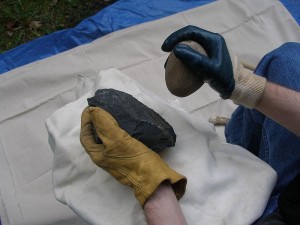
Homo habilis was the first species to exhibit enlarged Broca’s and Wernicke’s areas. They thus may have had the motor control that allowed more lingual activity and the ability to comprehend the resulting sounds they could produce. Great apes can comprehend symbols, i.e. this stands for that even though this bears no resemblance to that. They have been taught American Sign Language, various computer languages, and spoken language. Where they fall short is in syntax—they cannot string together symbols into meaningful sentences. I firmly believe that the descendant species of Early Homo, i.e. Homo ergaster, had theory of mind, based on their stereotypical production of tools. There had to be teaching, learning, and training involved in order to produce an implement that is readily recognized as an Acheulian hand axe (see Figure 23.4). Thus, since we see an earlier stage of tool production in Early Homo, I would argue that they had rudimentary language and theory of mind.
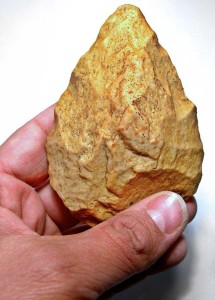
The Oldowan tradition lasted from approximately 2.5 to 1.5 mya but survived in some areas until 600 kya. Tools consisted of crude choppers (see Figure 23.6) and scrapers, as well as simple flake tools, some of which indicate that they were “retouched,” i.e. secondarily shaped and/or sharpened. In addition, there is evidence of possible wooden digging sticks or spears at the site of Koobi Fora, in the East Lake Turkana region of Kenya and possible bone tools at Olduvai Gorge.
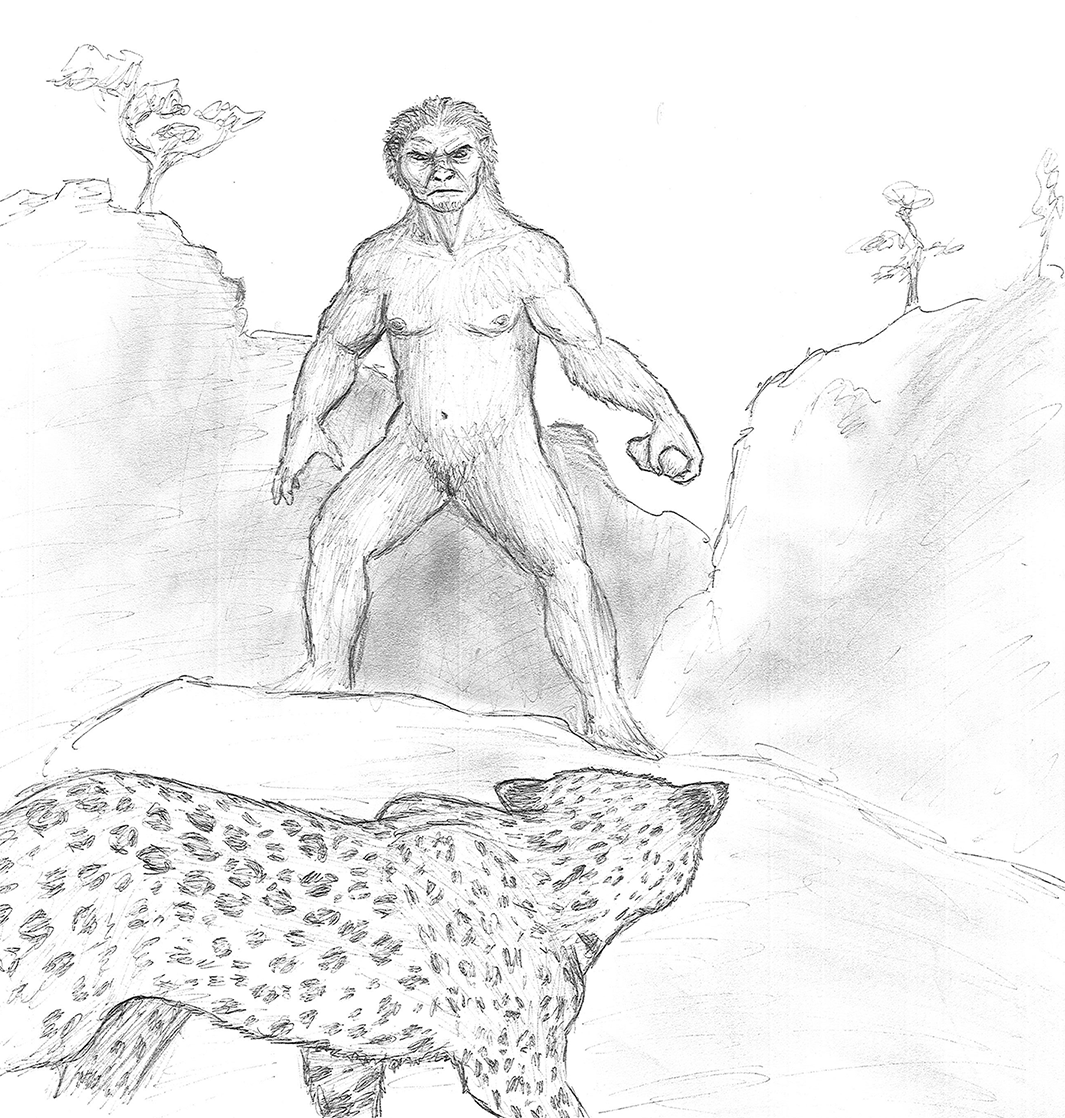
Tools were likely used for acquiring and processing both animal (scavenging, butchering, disarticulation, skinning, cutting flesh, chopping bones open, etc.) and plant (digging tubers, cutting stalks, pounding to break down fiber, etc.) foods. Indications of hominins having butchered and scavenged animals comes from several lines of evidence. First, tools have been found with H. habilis remains. Second, there are concentrations of tools and fossilized animal bones that exhibit signs of cutting, disarticulation, and marrow extraction. Mary Leakey mapped one such area with a high accumulation of stone tools and bones, known as site DK. Third, the high frequency of particular bones at some sites is indicative of the hominins having “brought back the good stuff,” i.e. skulls for brain and limb bones for meat and marrow. Fourth, microscopic analyses indicate that cut marks on some bones overlay predators’ teeth marks, showing that the hominins arrived afterward. How they got meat away from scary scavengers is anyone’s guess. Finally, experiments with modern-made stone tools in the Oldowan style reveal (1) that it is possible to butcher an elephant and (2) wear patterns that result from the butchering process match those found on ancient tools.
The following sites contain evidence of stone tools and their manufacture:
- Lomekwi 3, Lake Turkana region, Kenya (3.3 mya): cores, anvils, and flakes.
- Gona, Ethiopia (>2.5 mya): 3,000 stone artifacts.
- Hadar, Ethiopia (2.4 mya): tools were found with a H. habilis mandible.
- Olduvai Gorge, Tanzania (1.8 mya): numerous tools.
- Koobi Fora, Kenya: high concentration of flakes suggesting repeated use.
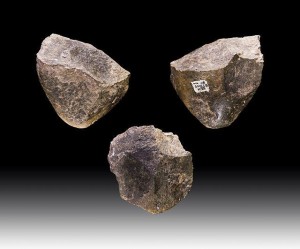
H. habilis are thought to have been forager-scavengers that collected wild plant foods, hunted small animals opportunistically, and scavenged carcasses from large predators. While there is evidence of “repeated-use” sites, meaning that individuals returned to particular areas to meet, they are not thought to have settled in any one area but rather moved about the landscape in their quest for food. They may have made use of those sites for a variety of communal or individual activities, such as grouping for “central place foraging” activities (from the animal literature, meaning to move out from and possibly return to a particular place), making new and/or using cached tools, butchering carcasses, sharing food, etc. Mary Leakey believed that her Site DK was indicative of a home base. While it is a romantic notion to look to modern hunter-gatherers with modern intelligence and advanced weaponry as being able to stay in one place until resources became scarce, it is not likely that those primitive hominins were camped out on a lake shore. It would have been a very dangerous place to be for long periods of time.
While they could have climbed trees and made sleeping nests in trees or on the ground, we do not know how much time they spent in the two microenvironments.
THE FIRST FAMILY OF PALEOANTHROPOLOGY: THE LEAKEYS
Louis Leakey (1903–1972) was born to British missionary parents residing in Kenya. He and his wife Mary made names for themselves with their pioneering work, searching for and discovering fossil hominins in East Africa. Louis is credited with the discovery of three hominin species, the first of which is considered to be a possible basal or stem ape, Proconsul africanus (“before Consul” [a famous chimp at the London Zoo]/“from Africa”). Louis was an early believer in an African human origin (Cartmill and Smith 2009). He became interested in the search for ancient hominins after his discovery of stone tools that he attributed to human ancestors. The Leakeys worked at Olduvai Gorge in Tanzania for many years. When Mary discovered the robust australopith that she named Zinjanthropus boisei (later to be changed to Australopithecus boisei and later to Paranthropus boisei), Louis proclaimed to the world that they had found his predicted “man the toolmaker.” According to legend, he was ridiculed by some because they felt that “Zinj” (also known as “Dear Boy” or “Nutcracker Man”), as the specimen came to be known, was an herbivorous ape that would not have had the mental capabilities to manufacture the tools that became known as the Oldowan technology. Louis was later rewarded with the discovery of fossils of a more derived hominin with a larger cranial capacity. He named the species Homo habilis (“Handy man”) as the first tool makers. There was and still is some controversy surrounding the classification of the species. He and his colleagues were accused of using cultural versus physical attributes to justify their inclusion of the fossil material in our genus Homo. Some still believe the species should be assigned to genus: Australopithecus. Regardless of the controversies, Louis made a name for himself and added to our knowledge of human ancestry. At Olduvai, he also discovered the cranium (missing its face) of a 1.2 mya H. ergaster individual. Another great accomplishment was sending the three “grand dames” of ape primatology into the field. He correctly believed that we can learn about ourselves from our closest relatives. He thus funded Jane Goodall to study the chimps of Gombe, Tanzania; Dian Fossey for her work with mountain gorillas in the Virunga Volcano region of Rwanda; and Biruté Galdikas to study the orangutans of Borneo.
Mary Leakey (née Mary Douglas Nikol, 1913–1996) is described on the Leakey website (www.leakey.com) as “one of the world’s most distinguished fossil hunters.” She is credited with the discovery of two species of early hominins, Au. afarensis at Laetoli and P. boisei at Olduvai, as well as the Laetoli footprints. (Laetoli is also in Tanzania.) Mary had an early interest in archaeology and, like Louis, excavated stone tools; in her case in France as a mere child. By age 17, she was auditing university courses in archaeology and geology. She met Louis in 1933 and accompanied him to Kenya to illustrate stone tools for a book he was writing. They married several years later and had three sons, Jonathan, Richard, and Philip. Jonathan hunted fossils along with his parents and discovered the first H. habilis specimen, a mandible known as “Jonny’s Child.” Richard moved into Kenya to work at sites around Lake Turkana, and his team discovered the oldest H. ergaster specimen (1.75 mya) in the West Lake Turkana region. In addition to his paleoanthropological work, he is a champion of wildlife conservation. His wife Meave is a renowned paleoanthropologist with several hominin species discoveries to her credit, and their daughter, Louise, is well on her way to making a name for herself (www.leakey.com).

